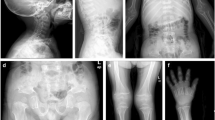Abstract
Background
Spondyloepimetaphyseal dysplasia, short limb-abnormal calcifications type (SEMD, SL-AC) is a rare autosomal recessive condition with a grave prognosis.
Objective
We aimed to describe the progression of symptoms from fetal age to adolescence in SMED, SL-AC patients.
Materials and methods
We retrospectively evaluated radiological findings on plain films, CT and MRI for eight children with genetically proven SEMD (male:female ratio 4:4, ages 30-week fetus to 18 years) and summarized findings from case reports and case series in the literature.
Results
Early and persistent radiological signs of SEMD were platyspondyly, chest narrowing, short ribs, and broad and short bones in the extremities and pelvis. In five children, we observed an unusually massive C2 vertebral body with narrowing of the spinal canal. Disease progression was characterized by anterior dislocation of C1, kyphoscoliosis, bowing of the limbs, metaphyseal and epiphyseal changes and abnormal calcifications. Earliest appearance of abnormal calcifications was 1.5 years; four children had no abnormal calcifications at diagnosis. There were persistent large open fontanelles in all children with skull radiographs, including a 17-year-old boy. Disease severity and progression were variable. Complications included cord compression and restrictive lung changes.
Conclusion
Disease severity and progression vary. Absence of abnormal calcifications does not preclude the diagnosis. An unusual, massive C2 vertebral body may contribute to spinal cord compression. Persistent open fontanelles should be added to the clinical characteristics of SEMD, SL-AC.





Similar content being viewed by others
References
Borochowitz Z, Langer LO Jr, Gruber HE et al (1993) Spondylo-meta-epiphyseal dysplasia (SMED), short limb-hand type: a congenital familial skeletal dysplasia with distinctive features and histopathology. Am J Med Genet 45:320–326
Langer LO Jr, Wolfson BJ, Scott CI Jr et al (1993) Further delineation of spondylo-meta-epiphyseal dysplasia, short limb-abnormal calcification type, with emphasis on diagnostic features. Am J Med Genet 45:488–500
al-Gazali LI, Bakalinova D, Sztriha L (1996) Spondylo-meta-epiphyseal dysplasia, short limb, abnormal calcification type. Clin Dysmorphol 5:197–206
Dias C, Cairns R, Patel MS (2009) Sudden death in spondylo-meta-epiphyseal dysplasia, short limb-abnormal calcification type. Clin Dysmorphol 18:25–29
Fano V, Lejarraga H, Barreiro C (2001) Spondylo-meta-epiphyseal dysplasia, short limbs, abnormal calcification type: a new case with severe neurological involvement. Pediatr Radiol 31:19–22
Smithson SF, Grier D, Hall CM (2009) Spondylo-meta-epiphyseal dysplasia, short limb-abnormal calcification type. Clin Dysmorphol 18:31–35
Tuysuz B, Gazioglu N, Ungur S et al (2009) The time of onset of abnormal calcification in spondylometaepiphyseal dysplasia, short limb-abnormal calcification type. Pediatr Radiol 39:84–89
Ali BR, Xu H, Akawi NA et al (2010) Trafficking defects and loss of ligand binding are the underlying causes of all reported DDR2 missense mutations found in SMED-SL patients. Hum Mol Genet 19:2239–2250
Bargal R, Cormier-Daire V, Ben-Neriah Z et al (2009) Mutations in DDR2 gene cause SMED with short limbs and abnormal calcifications. Am J Hum Genet 84:80–84
Greulich W, Pyle S (1959) Radiographic atlas of skeletal development of the hand and wrist. Oxford University Press, London
Lachman R (2006) Taybi and Lachman's radiology of syndromes, metabolic disorders and dysplasias, 5th edn. Elsevier Health Sciences, Philadelphia
Cormier-Daire V (2008) Spondylo-epi-metaphyseal dysplasia. Best Pract Res Clin Rheumatol 22:33–44
Maroteaux P, Le Merrer M (1990) Maladies osseuses de l'enfant (Broché) [in French]. Médecine-Sciences Flammarion, Paris
Acknowledgements
The authors did not receive outside funding in support of this study, and have no conflicts of interest to report.
We wish to thank Shifra Fraifeld for her editorial assistance in the preparation of this manuscript.
Author information
Authors and Affiliations
Corresponding author
Rights and permissions
About this article
Cite this article
Rozovsky, K., Sosna, J., Le Merrer, M. et al. Spondyloepimetaphyseal dysplasia, short limb-abnormal calcifications type: progressive radiological findings from fetal age to adolescence. Pediatr Radiol 41, 1298–1307 (2011). https://doi.org/10.1007/s00247-011-2123-2
Received:
Revised:
Accepted:
Published:
Issue Date:
DOI: https://doi.org/10.1007/s00247-011-2123-2




